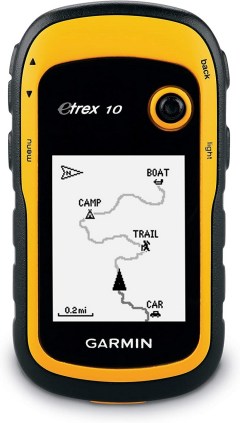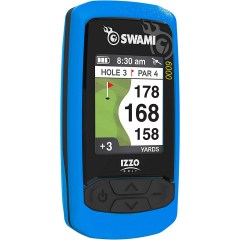BestReviews is reader-supported and may earn an affiliate commission. Details

Buyers like this GPS tracker for its longer battery life and inReach messaging that make using the device a breeze.
Buyers like this GPS tracker for its longer battery life and inReach messaging that make using the device a breeze.
Uses the 100% global Iridium satellite network for tracking and two-way messaging. View satellite imagery and preloaded TopoActive mapping to track your location. You'll get up to 165 hours in 10-minute tracking mode and up to 425 hours in expedition mode.
Some users find the initial setup to be somewhat complicated.

Despite the very low price point, this Garmin holds up to more expensive options on the market thanks to a wide range of features.
Despite the very low price point, this Garmin holds up to more expensive options on the market thanks to a wide range of features.
The unit makes fast connections with satellites. Offers good waterproof capabilities. Includes a 2.2-inch display screen that provides valuable information, but screen quality lags behind others. Well-below the average price point for an accurate GPS standalone device.
Only runs on AA batteries; no rechargeable battery.

The reliable eTrex 10’s interface makes this handheld GPS unit the best option for users who want something that will last a long time.
The reliable eTrex 10’s interface makes this handheld GPS unit the best option for users who want something that will last a long time.
Affordable price point. Features a crystal-clear monochrome display that is easy to understand and utilize when you don't know the trail or road you are on. Durable design. Up to 25 hours of battery life with 2 AA batteries. Utilizes GPS and GLONASS satellite positioning.
No compass feature.

You'll get up to 14 days of GPS tracking with this handheld device that works great for new and seasoned users.
You'll get up to 14 days of GPS tracking with this handheld device that works great for new and seasoned users.
Backpackers and other adventurers love this lightweight and small GPS tracker that has two-way messaging and global interactive SOS. Return to where you started by using TracBack routing and share your location with friends at home at any time.
Some trouble with the Android app not pairing with devices.

This GPS unit is designed to provide accurate measurements for golfing, with automatic recognition and handless viewing.
This GPS unit is designed to provide accurate measurements for golfing, with automatic recognition and handless viewing.
Auto-course settings recognize your distance measurements and field layout. Loaded with over 38,000 maps around the globe. Designed with a colorful display that is simple and easy to read. Simply put it onto your golf cart through the magnetic base.
Some complaints about the battery life.

We recommend these products based on an intensive research process that's designed to cut through the noise and find the top products in this space. Guided by experts, we spend hours looking into the factors that matter, to bring you these selections.

Global positioning systems (GPS) have become ubiquitous. You can find the technology in smartphones, tablets, and even some smart watches and fitness wearables. Handheld GPS units are used for navigating, geocaching, tracking jogs and trips, tagging photos, and powering hundreds of map-driven apps. Despite the availability of GPS applications in all this technology, there’s still a compelling need for a stand-alone handheld GPS unit that does one thing exceptionally well.
There is a wide assortment of handheld GPS units available in a variety of sizes, designs, and functionalities. While choice is good, it can make selecting a handheld GPS unit very challenging.
The BestReviews team welcomes the challenge of sifting through the various styles and features available in products to help you find the perfect item for your needs.
If you’re ready to buy a handheld GPS unit, check out our top picks. If you’re interested in learning more, let’s dive in and get some direction on the wide, wild world of handheld GPS units.

A handheld GPS unit is a key part of many traveling, trekking, camping, hunting, cycling, and fishing trips. It can be a lifesaver if you’re trying to find your way around a new place, especially if your cell phone doesn’t work. Getting lost is surprisingly easy to do.
If you’re at the mercy of an outdated map, bad weather conditions, or unexpected changes in trails, a reliable handheld GPS unit can be a lifesaver.
But no two handheld GPS units are exactly alike. In fact, even different models from the same manufacturer vary in style and functionality to some degree. While all handheld GPS units serve to find and track your location, different manufacturers include different features based on a variety of use cases.
Your own needs and biases will determine which models to include in your short list. Do you require more battery life, a more durable design for rougher conditions, or an easy-to-read display? Let’s go over some of the key features to consider when choosing a handheld GPS unit.
Accessing and tracking your location using global positioning satellites uses up a lot of power. Just try navigating for a few hours using your smartphone and you’ll see the battery level plummet.
The quality of your handheld GPS unit’s batteries is almost as important as what type of battery you use.
Some units run on rechargeable batteries, which is great if you have access to electricity. Others use battery packs or alkaline or lithium batteries, which means you’ll likely need to pack extras depending on the length of your trip.
Display size and quality is probably the most important feature for many users, especially since this is the component you interact with the most.
Different units come with everything from basic monochrome LCD displays to more detailed full-color screens.
You need to consider both daytime and nighttime use, as well as how readable the screen is in bright sunlight.
Most LED and LCD displays are built to last, however there’s always a possibility of screen burn in when some images are kept on for prolonged periods of time. The best way to test this is to try out the models you’re interested in and compare the performance.
Handheld GPS units come in many shapes, sizes, dimensions, and materials. Some are streamlined and look like smartphones or small tablets, while others have visible antennas, seeming to give them a more professional appearance (or at least reinforcing the idea of strong GPS reception).
Ergonomics is important, too. While we call these “handheld” units, not every shape is equally suited for grabbing or holding in the hand for extended periods of time.
Aside from how it feels to hold, a good handheld GPS unit should fit well in your pocket or be easily added to a belt or carabiner. It should also suit a wide range of users and hand-sizes.
Depending on the type of activity or the terrain you expect to cover, a handheld GPS unit’s build and materials will be a prime consideration. These devices are tools and should be expected to work in varying temperatures, humidity conditions and even last through rain showers.
Some GPS units are designed for all-weather conditions and can be splashed on or rained on. The material and build of a GPS unit, as well as the IP (Ingress Protection) rating will give you an idea of how resistant to the elements it is.
Most handheld GPS units are built of hard plastic or PVC, some have hardened rubber borders for shock absorption and better grip.
A handheld GPS unit is only as good as the maps it contains. This means not only making sure you have the right maps for your activities but also that you have the latest version of those maps.
Many GPS companies offer free, paid, or subscription-based access to maps. What you choose will depend on your needs.
To accommodate all of your maps, you also need to consider the built-in or expandable storage space in your unit. As with smartphones and computers, we advise getting more storage space than you think you need so you can give your map list room to expand.
Beyond GPS navigation functionality, GPS makers like to add features to differentiate their products from the competition.
All extra features tend to add to the cost. They might be nice to have, but they should never come at the expense of a solid, accurate handheld GPS unit.
Some of these extra features include the following:
Electronic compass
Smartphone connectivity (to download maps and firmware updates)
Activity-specific features (trip computer, sunrise/sunset times for hunting/fishing information)
WiFi
Remote location tracking
SOS/beacon for emergencies
Digital camera
Handheld GPS units vary widely in price. You can expect to spend from $80 to $700, although there’s a great range of products that should satisfy most needs in the $200 to $400 range.
For $80 to $200, you can get a unit with a monochrome display and protection against splashing and rain.
For $200 to $400, you can get a rugged, water-resistant unit with a compass, barometer, and accelerometer.
For $400 to $700, you can get a unit with a 65k colored, sunlight-readable display, IPX7 water and dust resistance, and 5,000 waypoints.

Q. What is GPS?
A. GPS is the acronym for “Global Positioning System.” The system was developed by the U.S. Department of Defense. People on land, sea, and in the air can use it to determine and visualize their 3D orientation in space and time.
Q. How does GPS work?
A. GPS receivers collect signals from satellites in their line of sight. The signals relay information about velocity, position, and time. When used with apps and smartphones, GPS can enable various applications such as ride-sharing apps, community-based traffic, navigation apps, and search-and-discovery mobile apps.
Q. How accurate is GPS?
A. The U.S. government claims a minimum four-meter horizontal accuracy for civilian GPS. Many of today’s handheld GPS units are 95% accurate for up to three meters.
Get emails you’ll love.
Learn about the products you’re wondering if you should buy and get advice on using your latest purchases.
